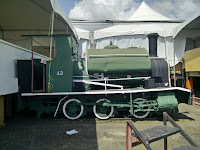 |
| TGR No.24 at Pointe a Pierre en route to siparia. |
 |
| Engine "D" at Port of Spain Museum |
Many of the country’s generation never knew that at one time, trains operated throughout the country. The Trinidad Government Railway consisted of over 120 miles of standard gauge rail which ran from Port of Spain to Arima and Sangre Grande in the East (the line between Arima and Sangre Grande was closed in the early 1950s) and to the southwest to San Fernando and to Rio Claro along the Caparo Valley line with the famous Knolly’s Tunnel. The Rail system comprised of 27 standard gauge locomotives which included 18 steam and 9 diesel locomotives.
In the mid-1800s the railway was introduced into the southern areas of the country with the primary purpose of transporting sugarcane, which was the main product produced in Trinidad, to the sugar factories. Over the years, the railway started to diversify into transporting other products and passengers. In 1876, the Trinidad Government Railway (T.G.R.) was established and rail lines were laid throughout the country to the East at Arima and Sangre Grande and to the South at San Fernando and Rio Claro. With the railway stations located at most major towns, many of these towns such as Chaguanas, Couva and Penal became heavily populated and heavily urbanized overtime as products and passengers were transported throughout the country at a fairly cheap price. With oil being heavily produced in the 1940s, diesel locomotives began arriving into Trinidad, mostly having the task of hauling sugarcane from the field stations to the factories of Brechin Castle in Couva and Usaine St. Madeline in South Trinidad.
By the 1950s and 1960s with the introduction of the motor vehicle, which had advantages over train locomotives and that the railway company was making deficits due to high maintenance and running costs, the rail lines were gradually closing down. It started with the line between Arima and Sangre Grande in the early 1950s. It continued into 1965 when the Southern lines were closed down. On August 30th 1965, a steam locomotive, TGR No.27 hauled “The Last Train to San Fernando” on that faithful evening. By 1968, the only line running under the T.G.R. was from Port of Spain to Arima. On December 31st 1968, the last T.G.R. train rolled into Port of Spain and with that, the Trinidad Government Railway was officially disbanded.
Although the TGR was disbanded, trains continued running under Tate and Lyle Sugar Company and Caroni (1975) when the latter took over operations. The trains continued hauling sugarcane from the fields to factory. In 1976, the rail lines around the Brechin Castle factory was closed down. On May 15th 1998, almost 30 years since the T.G.R. was disbanded, the last 20 miles of track around Usaine St. Madeline factory, and in Trinidad, was closed.
Today, remnants of the former rail system live on as static attractions like the 4 diesel locomotives at the Sugar Heritage Museum on the grounds of the Brechin castle factory in Couva, the steam locomotives at the Port of Spain Museum and Harris Promenade in San Fernando. The Knolly’s Tunnel near Tabaquite is one of a very few railway infrastructure that remains in Trinidad.
There are several videos that highlight the Trinidad railway:
1. Video showcases the train in action in Penal in 1957 for the construction of the power station there. Courtesy of oldtimecalypso on youtube - https://www.youtube.com/watch?v=vkKadjfMlgw&nohtml5=False
2. This video highlights the Last Train to San Fernando in 1965. Courtesy of Glen Beadon
https://www.youtube.com/watch?v=sdkz-rZs3s0&ebc=ANyPxKpc24bGpZJ_5Q7tdALEZVaBkoGOalX1Q_5BlOVgG-h8ki7Wy0QAbEk09YciAcdL851zwQc_15Ib-sXTK2mrc3COPJWjNQ&nohtml5=False
Glen Beadon is a Trinidad- born railway researcher who studies various railways including the trains in Trinidad.
Link:https://www.youtube.com/channel/UC4v8c_acdg-sN88QxOrD6aA?nohtml5=False
Reflection:
The reason that this picture of the locomotive was taken at this angle was because, in my opinion would show the transition of transport from the past to present. Due to renovations taking place at the museum, tents were constructed thus blocking the background of the roadways. However if we decided to remove these tents, we can clearly see the maxi stand in the background. This shows transition between the past, with the locomotive and the present transport system. It is quite surprising that the engine has the number 42 when in fact the name of the train was called Engine "D".
Reference: http://www.trinidadexpress.com/news/Story-of-the-tracks-to-Siparia-270697891.html
https://www.youtube.com/watch?v=sdkz-rZs3s0&ebc=ANyPxKpc24bGpZJ_5Q7tdALEZVaBkoGOalX1Q_5BlOVgG-h8ki7Wy0QAbEk09YciAcdL851zwQc_15Ib-sXTK2mrc3COPJWjNQ&nohtml5=False
Glen Beadon is a Trinidad- born railway researcher who studies various railways including the trains in Trinidad.
Link:https://www.youtube.com/channel/UC4v8c_acdg-sN88QxOrD6aA?nohtml5=False
Reflection:
The reason that this picture of the locomotive was taken at this angle was because, in my opinion would show the transition of transport from the past to present. Due to renovations taking place at the museum, tents were constructed thus blocking the background of the roadways. However if we decided to remove these tents, we can clearly see the maxi stand in the background. This shows transition between the past, with the locomotive and the present transport system. It is quite surprising that the engine has the number 42 when in fact the name of the train was called Engine "D".
Reference: http://www.trinidadexpress.com/news/Story-of-the-tracks-to-Siparia-270697891.html

No comments:
Post a Comment